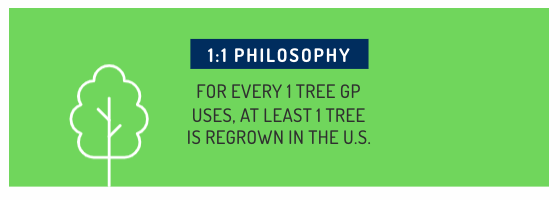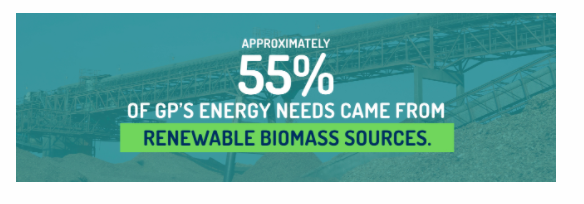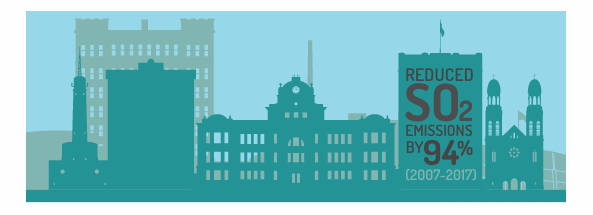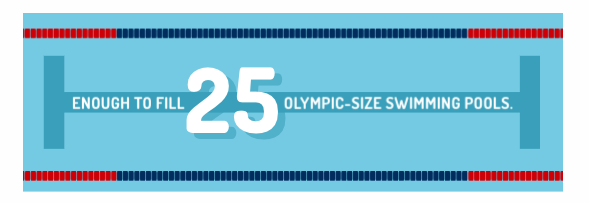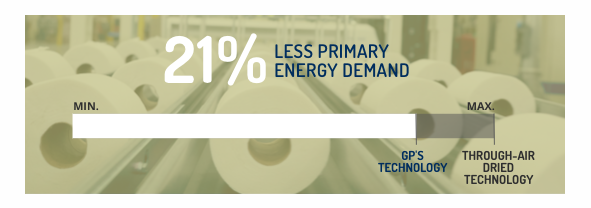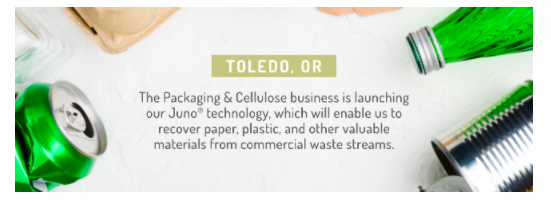Sustainable Business: 6 Ways Georgia-Pacific is Leading Industry in Sustainability
Georgia-Pacific’s 2020 sustainability report highlights investments in renewable energy, reduced emissions and recycled resources
From paper towels to building materials, employees at Koch company Georgia-Pacific make products used by millions every day. Focused on the long term, we work to constantly improve and innovate – both in the products we make and how we make them – to benefit our customers, employees, communities, the environment and society. Georgia-Pacific has released a sustainability report that delivers a comprehensive view of recent initiatives and investments to use energy more efficiently, reduce more emissions and recycle more resources.
Here are six key points from Georgia-Pacific's sustainability report:
1. REPLENISHING FORESTS
For every tree Georgia-Pacific uses, at least one is planted. And of the trees Georgia-Pacific uses, virtually every part is used. In addition, Georgia-Pacific has planted more than 1 million trees through direct investments in conservation projects, and has planted more than 400,000 trees on properties surrounding company facilities.
2. COMMITTING TO RENEWABLE ENERGY SOURCES
The largest source of energy in Georgia-Pacific’s operations? Biomass. New biomass systems, such as the one installed at Georgia-Pacific's Naheola mill in Pennington, Alabama, process paper-making byproducts (tree bark, sawdust, and other organic material) as energy sources. Georgia-Pacific has replaced seven power boilers with natural gas or biomass units. In fact, the amount of biomass Georgia-Pacific uses for energy is 9% of the total electricity generated from woody biomass in the United States.
3. INVESTING IN AIR QUALITY IMPROVEMENTS
Georgia-Pacific’s Broadway Mill in Green Bay, Wisconsin, invested in improvements that immediately reduced sulfur dioxide (SO2) emissions. That facility decreased its SO2 emissions by 94% between 2007 and 2017. Overall, Georgia-Pacific’s facilities drove a 59% decrease in SO2 — nearly 30,000 tons — over the same period.
4. KEEPING WASTE OUT OF LANDFILLS
82,552 cubic yards. That’s how much process waste the Naheola mill diverted in 2019 to energy and reuse, keeping it out of landfills. The waste reduction totaled 88% of the facility’s total waste — enough to fill 25 Olympic-size swimming pools.
5. MORE EFFICIENT ENERGY USE
According to a 2017 Life Cycle Assessment, Georgia-Pacific’s proprietary tissue technology (eTAD) is less energy-intensive on a per-usage basis compared to conventional through-air drying (TAD) technology, a widely accepted industry process. With eTAD, a percentage of water is mechanically removed and recycled before the drying stage of the manufacturing process. This reduces energy demand by 21%, among other benefits.
6. RECYCLING RESOURCES
Georgia-Pacific is investing in ways to use recovered paper more economically when manufacturing new products such as paper towels and corrugated boxes. That includes increasing the capability to both recover and process used paper goods. Georgia-Pacific has increased its capability to process mixed paper at its facilities by more than 50%. In addition, drawing on many years of experience in paper recycling, Georgia-Pacific has developed a process that converts waste from places such as office buildings, restaurants, airports, stadiums and schools into valuable recyclables. This new Juno® Technology can divert up to 90% of commercial waste from landfills and incinerators.
These efforts not only lead the way in sustainably managing resources – they’re also earning national recognition from environmental and industry groups. After Alabama’s Naheola mill installed a new biomass-fired boiler as a new energy source, it was recognized as the 2019 EPA Energy Star Project of the Year for reducing air emissions. Along with Koch company KBX Logistics, Georgia-Pacific earned the EPA’s 2019 SmartWay® Excellence Award for improving energy efficiency and supply chain environmental performance. And three paper mills — in Muskogee, Oklahoma; Palatka, Florida; and Green Bay, Wisconsin — achieved the EPA Energy Star Challenge for Industry goal of reducing energy intensity by 10% within five years.
Download Georgia-Pacific's full 2020 sustainability report here.

